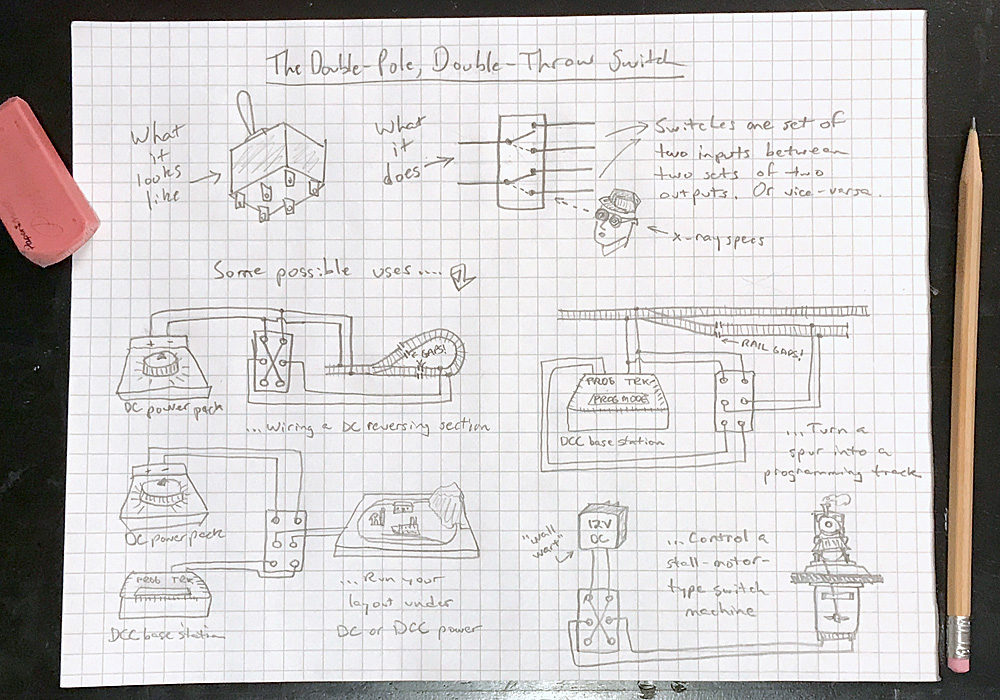
On a railroad, a switch usually refers to the moving parts of a turnout that routes a train between two possible routes. This time, though, we’re talking about an electrical switch: specifically, a double-pole double-throw switch (DPDT).
It’s easy to understand a single-pole single-throw switch: it only has two states, open or closed, off or on. To grasp how a double-pole double-throw switch works, think of it like a railroad switch. The single track in, at the point end, is the pole; the two rails correspond to the two poles, usually positive and negative with a direct-current circuit. The two routes out of the turnout are the throws. Depending on how the switch is thrown, the two rails of the pole could connect to either set of rails. It’s the same way with electricity.
Check out the top of the sketch. The middle two contacts are the poles. Call those pins 3 and 4. On one side of that pair are pins 1 and 2, and on the other side, pins 5 and 6. Those are the throws. When the switch is thrown one direction, contact is made between the poles and one pair of throws: Pin 3 connects to pin 1 and pin 4 to pin 2. Thrown the other way, the poles contact the other pair of throws: pin 1 connects to pin 5 and pin 4 to pin 6. The guy with the X-ray specs shows you how the DPDT works on the inside.
Note I haven’t referred to inputs and outputs yet. That’s because either set could be the input or the output. The switch can select between two sets of inputs for one output, or select one input to go to either of two outputs.
The DPDT is one of the most useful switches in wiring a model railroad. I’ve sketched out four of the most common uses.
The first shows how to use a DPDT to control polarity in a reversing loop under DC control. Notice how pin 1 is cross-wired to pin 6, and pin 2 to pin 5. The poles are the output to the rails in the reversing section. Throwing the switch reverses the polarity.
Below that sketch is an example that has two inputs, one output. If you want the advantages Digital Command Control brings, like sound, easy consisting, and realistic features like momentum and braking, but don’t want to convert all your old locomotives to DCC yet, try this setup. Flip the switch one way, and you can run all your old engines under DC block control. Then flip it the other way and run your new ones under DCC. Layouts wired for DC usually need very little modification to run under DCC.
The third example also switches one output between two inputs to turn a spur on your layout into a programming track. Gap the rails to separate the spur electrically from the rest of the layout, then connect a separate set of feeders through a switch wired as shown. By flipping the switch, you switch the isolated track to the programming track output of your DCC base station. Then when you’re done programming, flip the switch again and drive your locomotive onto the layout – no 0-5-0 switching needed. Pay attention to rail polarity when wiring the track-power throw to the switch, or you could get a short.
The final example shows how to wire a DPDT switch to control a stall-motor-type switch machine. This kind of switch motor requires constant voltage to hold the turnout points in one direction or the other. Like in the first example, we use the cross-wiring trick to reverse the polarity of the direct current leading to the switch motor’s inputs. This makes the motor run in the other direction and lines the turnout points the other way.
Many stall-motor switch machines, like the Tortoise by Circuitron and the Walthers Layout Control System switch machine, come with internal DPDT switches that change when the points move. This lets you use the switch motor to control trackside signals, control panel indicators, or even other switch motors! So get some DPDTs and start reversing the polarity, old chum. Batman would be proud.














You mention, but don’t show, the DPDT contacts on a Tortoise (by Circuitron) to power a frog or operate position lights on a panel. Maybe in part 2?
Roger Thomas